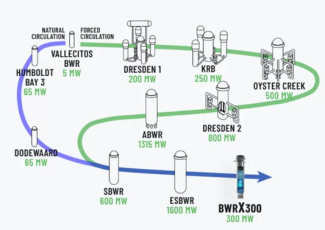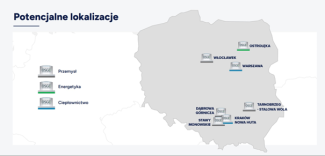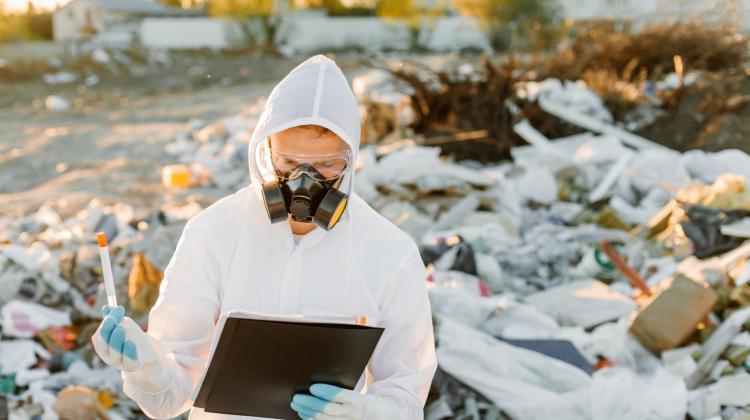How is a nuclear power plant better than coal-based power plants?
Enriched to 5% 235U is used as nuclear fuel. 1 gram of uranium generates as much energy as 3 tons of coal. The fuel charge for a typical reactor is about 30 tons. This amount is enough for a year of continuous operation of such a reactor. During the operation of the NPP, no by-products are generated that end up in the environment - where in the case of coal, carbon dioxide, heavy metals etc. end up in the atmosphere.
Is the NPP like the bomb from the latest Oppenheimer film, capable of destroying entire cities?
The answer to this question is simple - of course not. The basis of the operation of the NPP, like the bomb, is the fission phenomenon, where respectively heavy atomic nuclei (most often 235U) are decayed into 2 smaller nuclei. This is accompanied by the emission of neutrons, gamma rays. All fission product particles have very high kinetic energies (about 170 MeV for fission fragments). The resulting neutrons interact with subsequent heavy nuclei, leading to further decays. Commercial, nuclear power reactors use uranium as fuel, specifically uranium enriched to about 5% in the isotope 235U (naturally occurring uranium has only 0.7% of this isotope, the remaining 99.3% being the weakly radioactive 238U). In the case of an atomic bomb, the entire load of uranium is the isotope 235U, and once the fission reaction is initiated, we cannot control it. With the right nuclear reactor design and the right nuclear fuel (see 5% 235U) encapsulated in fuel elements, the fission reaction is completely controlled by us. During normal operation of the reactor, the so-called critical state is reached, in which the fission reaction spontaneously sustains itself (the so-called neutron multiplication factor kef is equal to 1). In simple terms, to control the reaction taking place in the reactor, you need control over the neutrons being produced. For this purpose, materials that can effectively absorb neutrons (for example, containing boron) are used, which are placed in control rods*. Insertion of such rods will cause absorption of neutrons-inhibition of the fission reaction. The reactors use additional, redundant safety rods that automatically retract into the reactor to stop reactions in the event of an accident. The energy generated during the decays is converted into heat, which heats the water that is the moderator and coolant for the reactor. The water is directed to heat exchangers, where steam is generated to drive a turbine (analogous to conventional power plants) producing electricity.
What about radioactive waste?
Spent nuclear fuel is recycled, of the approximately 30 tons of nuclear fuel, about 29 tons are reused. The remaining 1 ton of waste undergoes a vitrification process (it is flooded with special glass) and protected. Advanced work is currently underway around the world to establish repositories for high-level radioactive waste. Despite everything, it is estimated that if each of us used only nuclear power throughout our lives, the amount of waste per person would be the size of an apple that fits in the palm of your hand.
Is a nuclear power plant safe?
There are several safeguards in modern nuclear power plants to prevent reactor damage. The first is the previously mentioned safety rods, in an emergency they fall automatically into the reactor (in most designs this system works by gravity, without power). The nuclear fuel itself is housed in special zirconium shrouds - there is no physical contact with the reactor coolant. Modern reactors are built in such a way that as the temperature rises, their power is reduced - this protects against the failure of cooling systems. The reactor itself is housed in a special building capable of withstanding a direct hit by a passenger plane. In addition, all safety systems, including pumps, are duplicated. All the above and the safety culture of such a reactor makes a repeat of the Chernobyl tragedy impossible.
What does the Polish NPP program assume?
The goal of the program is to build between 6 and 9 GWe of installed nuclear capacity in Poland based on proven, large-scale, pressurized water nuclear reactors (PWRs) of Generation III and III+. The schedule calls for the construction and commissioning of 2 nuclear power plants with 3 reactors each. It is likely that the project of the US company Westinghouse (AP1000 reactor) in the municipality of Choczewo in Pomerania will be selected for construction. At the second location, Konin, a Korean-made APR-1400 (KEPCO) power plant is to be built. A third, additional location, Belchatow, was recently announced. In addition to "classical" nuclear reactors, work is underway to introduce small modular reactors (SMRs-an innovative technology that has not yet been introduced anywhere else in the world (SMR technology is certified by the US Nuclear Regulatory Commission). ORLEN Group plans to implement BWRX-300 technology developed by GE Hitachi. The BWRX-300 is a water-cooled, natural-cycle, small modular reactor (SMR) with a capacity of 300 MWe. It has passive safety systems that use the design and licensing basis of GEH's earlier design, the 1520 MWe ESBWR reactor, which went through the licensing process in the United States.
Modular nuclear reactors meet the same stringent requirements as those used for large nuclear power plants. As many as 76 SMRs are planned for 26 locations. The first locations presented are: Włocławek, Ostrołęka, Warsaw, Stawy Monowskie, Kraków-Nowa Huta, Stalowa Wola-Tarnobrzeg, Dąbrowa Górnicza.
What will the NPP in Poland give us?
It is estimated that the electricity generated by such a power plant can be as much as 4 times cheaper than electricity from coal. Having nuclear power will make Poland independent of importing fossil fuels such as natural gas. In addition, the construction of power units will allow the development of high technology and safety culture.
Is Lodz University of Technology participating in the nuclear power program?
Our unit, the Interdepartmental Institute of Radiation Technology (MITR), has been actively involved in activities aimed at developing NPP technology for years. Among other things, the Institute cooperates with the State Atomic Agency (PAA) and the International Atomic Energy Agency (IAEA) in monitoring radioactive contamination. Thanks to the possession of the most active radioactive sources in Poland (a radiation chamber and an electron gas pedal), work is being carried out on materials for securing radioactive waste and new materials are being developed for use in NPPs (e.g., high-dose ionizing radiation dosimeters). Specialized training is also being organized for the National Fire Service in rescue work at radioactive contamination. In response to the needs of the industry, a postgraduate program in nuclear energy is being launched from October 2023 to prepare future personnel for work in the sector.






